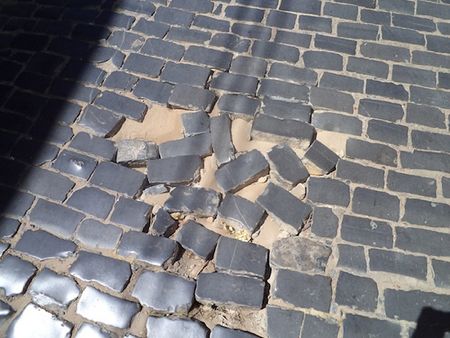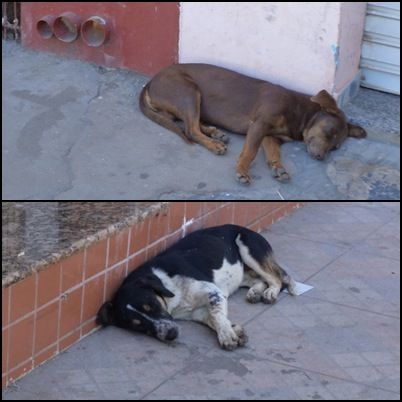The seven-week citizen media project currently taking place in the town of Januária in Minas Gerais, Brazil is coming to its conclusion with a graduation and celebration planned for the weekend of October 15. Organized by the group Friends of Januária [1], the project has been training 14 young people, who applied to take part in the course that is teaching them how to use citizen journalism for local government monitoring. Throughout the two-day workshops held each weekend, the participants have been using a combination of field data collection through documenting their observations and interviewing of city residents, and online research to find out about possible solutions for making the city a better place to live.
 [2]The group has been publishing on the collective blog Amigos de Januária [3], and also uploading digital photos and videos on their Flickr [4] and YouTube [5] accounts, respectively.
[2]The group has been publishing on the collective blog Amigos de Januária [3], and also uploading digital photos and videos on their Flickr [4] and YouTube [5] accounts, respectively.
In addition, the project organizers have been doing a great job of updating their progress on the Rising Voices project blog [6], where they include information about guest speakers, weekly activities, and the overall implementation of the project. They have also made the curriculum materials (.pdf format) [7] available online for download.
Here is a sample of a few of the blog posts written by the participants and translated into English:
Priscila Souza de Carvalho often notices that walking through the city can be quite hazardous because of the uneven sidewalks that can make it difficult to reach one's intended destination. For example, she notes that the lack of a sidewalk near the Viva Vida Health Center has made it difficult for pregnant women to make it to their appointments. For the story, Priscila talked with city residents about their opinions on these walkways [pt] [8] and about the citys’ duty to provide this safe transit:
Mas não é o que vemos, a principal rua de maior movimentação da cidade a Avenida Cônego Ramiro Leite os pedestres tem pelo menos duas reclamações principais que os fazem atravessar a avenida pela calçamento de carros, motos e bicicleta. Primeiro a irregularidade das calçadas com grandes degraus ou por vezes tomada por postes de iluminação ou semáforo que torna inviável a passagem de pedestres principalmente idosos, gestantes ou portadores de necessidades. E segundo é a utilização inadequada dos calçamentos para exposição de produtos ou até um estacionamento extinguindo a calçada.
After writing these observations, she referred to the Brazilian Agency for Technical Standards [10] to learn about what is required for public spaces.
An action by the municipal government to relocate street food vendors to a new location near the Old Highway in Januária was at first, well-received. However, citizen journalist Hellen Sofia notes that the new initiative lacked foresight from the authorities because of the amount of garbage that is being produced and not addressed. Her post is called “Food Plaza or Garbage Plaza? [pt] [11]” She also spent time speaking with those affected:
“Aqui se produz uma enorme quantidade de lixo e pagamos os carroceiros para jogarem em algum lote vago ou dá aos porcos, as vezes fica até nojento de parar aqui para comprar algo”. Palavras de um dos vendedores do local. A ideia foi bacana, mas tinha que ser bem elaborada desde a produção dos alimentos até a dispersão deles, tanto por parte das autoridades responsáveis e pelos vendedores. Pensaram em tudo, mas esqueceram o principal, pra onde que vai todo esse lixo?
In addition to interviewing city residents about these problems, the participants of the project also take to the streets to document some of their observations. Luana Ramos took part in the field assignment to photograph issues in the community that she was curious about. She was surprised by the number of abandoned and stray dogs on the streets of Januária. After some research, she learned how the local authorities deal with the issue [pt] [12]:
De acordo com pesquisas feitas durante a semana, a Fundação Nacional de Saúde (Funasa), atualmente só realiza o trabalho de recolhimento dos animais doentes, para serem sacrificados, os demais são vacinados e soltos novamente nas ruas, já que em Januária não existe um canil para abrigar esses animais. A Funasa de Januária possui um veículo com carrocinha responsável pela captura dos animais pela cidade. Segundo informações levantadas em média 200 cães doentes são sacrificados por mês, sendo que as doenças mais comuns são o calazar e a sinomoze.
Over the next few weeks, Rising Voices will have more translations of these posts, as well as photographs and videos produced by the young people of the Friends of Januária citizen media project.

